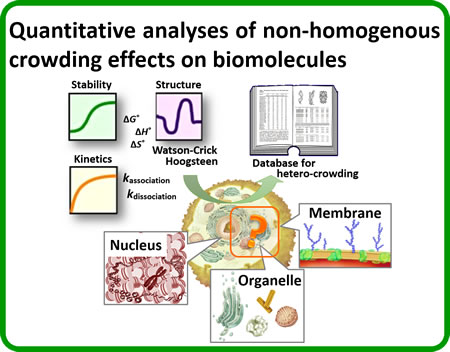
FIBER has been quantitatively analyzed to show an effect of molecular crowding environments on the physicochemical properties of functional biomolecules. We are now considering to further advance this research project. Cells establish a highly compartmentalized non-homogeneous environment in which various subcellular organelles are separately and cooperatively functionalized. To understand the functions of biomolecules, including nucleic acids, in all cellular conditions, it is important to consider the effects of the non-homogeneous crowding conditions on the functions of biomolecules. We are quantitatively analyzing the structures and stabilities of nucleic acids in environments containing actual biomolecules existing at intracellular compartmentalized sites, such as DNA (nucleus), skeletal proteins (cytosol), and the lipid bilayer (membrane).
Reference
-
H. Yaku, T. Murashima, D. Miyoshi, and N. Sugimoto
In vitro assays predictive of telomerase inhibitory effect of G-quadruplex ligands in cell nuclei
J. Phys. Chem. B, 118, 2605-2614 (2014) -
A. B. Rode, T. Endoh, H. Tateishi-Karimata, S. Takahashi, and N. Sugimoto
Real-time monitoring of DNA hybridization kinetics at living cell surfaces
Chem. Commun., 49, 8444-8446 (2013) [Selected as a Front Cover and Hot article] -
H. Yaku, T. Murashima, D. Miyoshi, and N. Sugimoto
Anionic phthalocyanines targeting G-quadruplexes and inhibiting telomerase activity in the presence of excessive DNA duplexes
Chem. Commun., 46, 5740-5742 (2010)